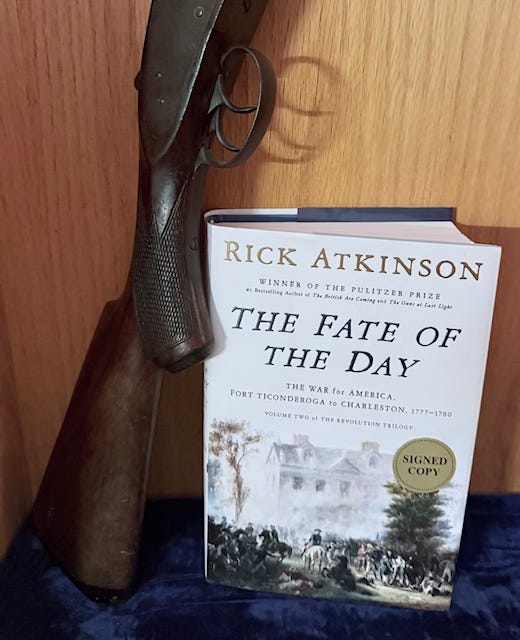"Cheat" Sheet of THE FATE OF THE DAY
Atkinson's brilliant second volume meets ChatGPT!
The following is a Cheat Sheet of notes I wrote while reading Atkinson’s THE FATE OF THE DAY – the recently published second volume in his planned trilogy on the American Revolution. Before giving a brief huzzah to a great book, I must point out that the following summary is straight from Chat GPT’s organizing of the raw notes. I am not using it because it is easier. I am including it because it is utterly unnerving how powerful an instrument it is. I very much hope you read Chat’s summary.
This book is one of the best histories, not just military, that I have read. A critic is right who wrote that Atkinson is to historical writing what Sinatra is to singing. He combines a gifted level of fluency with an equally soaring level of research to create a revision of our Revolution that I am sure will be the new standard. Now, it is ChatGPT’s turn …
1. Myth vs. Reality: The True Nature of the War
Atkinson dismantles the romanticized narrative of the American Revolution as a clean, idealistic uprising by a few determined patriots against a distracted empire. Instead, he presents it as a brutal, protracted, and chaotic war of attrition between a populous, increasingly radicalized insurgency and an overstretched, faction-ridden imperial force.
• Brutality on the Ground: One-third of all wartime deaths came from bayonets—signaling vicious, close-quarters combat. Muskets were largely ineffective (1% accuracy), and supply lines were excruciating, exacerbating British vulnerability.
• Psychological and Political Toll: Like Vietnam for the U.S., the British lost not just on the battlefield but in public perception and political will. They failed to win over the American populace, and their military efforts were continually undercut by bad intelligence, poor strategy, and demoralization at home.
2. Strategic Failures and Delusions
• Philadelphia and Howe’s Blunder: The British capture of Philadelphia was both tactically hollow and strategically disastrous. It gave a false sense of Loyalist support—especially in cities like Philadelphia, which misled British command into overestimating their popular base.
• The Tory Illusion: Loyalist support never exceeded 20% of the white population and was shrinking fast. Many fled to Canada or the West Indies. The war’s political center of gravity remained with the Patriots, despite their internal dysfunction.
3. Scale and Stakes of the Conflict
• Not a Colonial Skirmish, but a Global War: By 1778, after Saratoga, France entered the war—partly spurred by early British peace overtures. Spain followed. This transformed the Revolution into a world war.
• Naval Arms Race & Global Theater: The Royal Navy, the largest organization in the world at the time, played a central role. Each ship-of-the-line required massive resources (e.g., 6,000 oak trees, 32 miles of rope), illustrating the industrial and ecological cost of maintaining empire.
• John Paul Jones and Naval Heroics: American privateering and iconic battles like that between Bonhomme Richard and Serapis showed that the revolutionaries could challenge Britain even on the seas.
• Unwinnable War: Britain lost a quarter of its merchant marine to privateers. It was economically and logistically unfeasible to both defend the sugar islands, protect home waters from invasion, and subdue the American colonies simultaneously.
4. Disease, Death, and the West Indies
• King Sugar’s Dark Cost: Britain’s obsession with its Caribbean sugar colonies drained resources. Entire regiments sent to Jamaica perished from disease without firing a shot—e.g., 18 survivors out of 1,000.
• Warships as Floating Tombs: Naval warfare in the 18th century was defined more by disease than by battle, with life aboard ships often amounting to a death sentence.
5. Collapse and Radicalization
• Southern Theater and British Atrocities: As the British campaign shifted South, their tactics became increasingly barbaric. Yet these actions only hardened American resistance.
• Currency Collapse & Internal Decay: Late-war America was full of hardship—worthless currency, unreliable French support, opportunism—but the prolonged struggle forged a deeper identity and attachment to independence.
• Washington’s Endurance: Despite everything, Washington’s leadership remained a pillar of stability. The drawn-out war, rather than disillusioning Americans, forged national unity through shared suffering.
6. Home Front Unrest and British Instability
• Gordon Riots in London (1780): Domestic chaos in Britain—like the week-long anti-Catholic riots in London—revealed the fractures at home. Imperial overreach was not just unsustainable overseas, but destabilizing internally.
Conclusion
Atkinson’s work transforms the Revolution from a clean tale of liberty into a grim epic of survival, brutality, and global entanglements. It reframes the war as:
• A civil war complicated by international geopolitics.
• A protracted insurgency resisted by an empire unwilling to adapt.
• A war of myths, where sanitized patriotism overshadows the brutal, sprawling reality.
Atkinson, in this view, composes not just a revision but an orchestration—replacing the genteel string quartet of textbook history with a full symphonic clash, complete with “drums and all.”
There you have it …
I need to “process” this. I realize it came from my NOTES; however, I would have been stretched to organize them in such a good and accurate fashion.
Would appreciate any comments …
Thank you


